warning YAMAHA WR 250F 2017 Owners Manual
[x] Cancel search | Manufacturer: YAMAHA, Model Year: 2017, Model line: WR 250F, Model: YAMAHA WR 250F 2017Pages: 432, PDF Size: 14.14 MB
Page 6 of 432
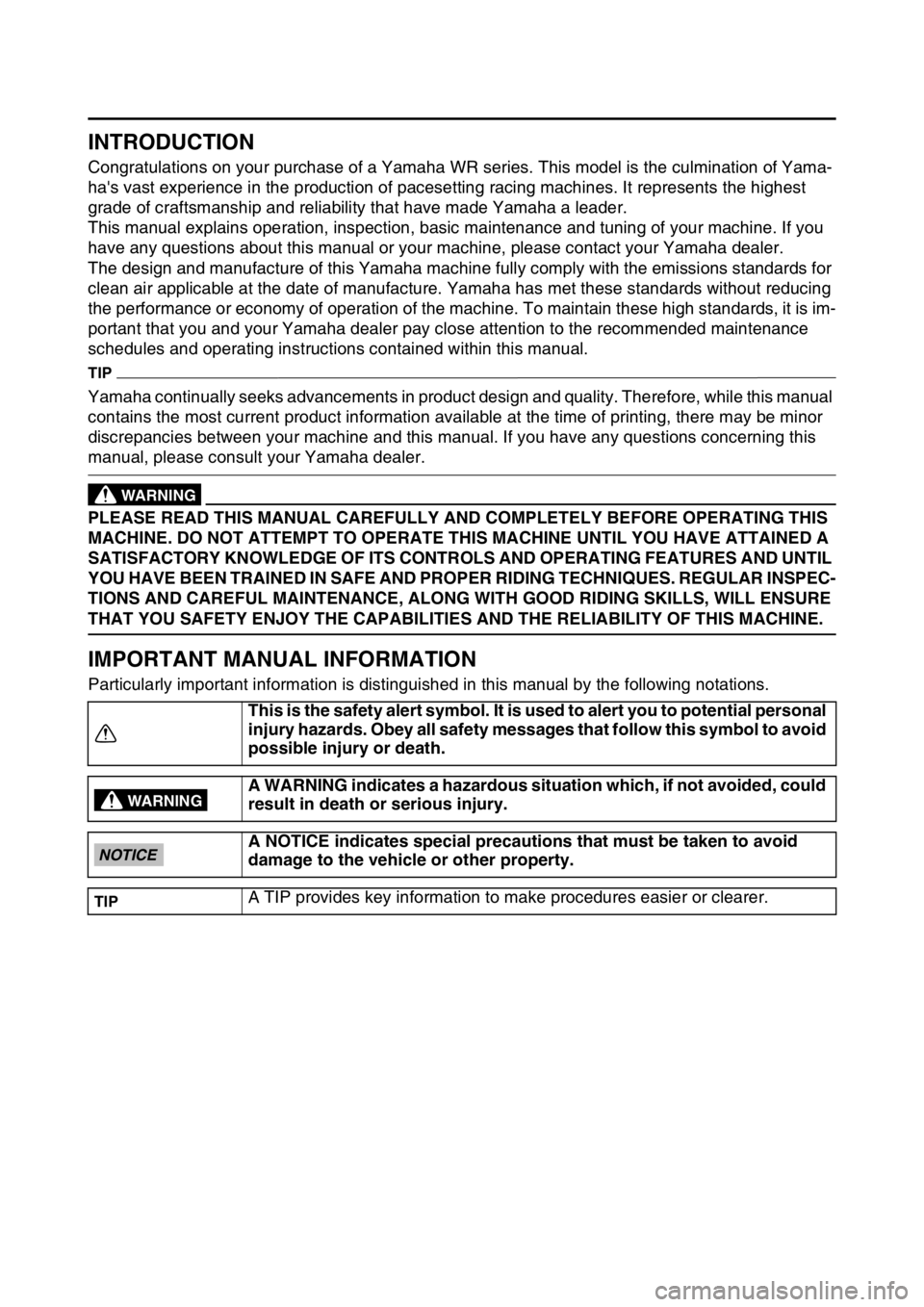
EAS2GBB003
INTRODUCTION
Congratulations on your purchase of a Yamaha WR series. This model is the culmination of Yama-
ha's vast experience in the production of pacesetting racing machines. It represents the highest
grade of craftsmanship and reliability that have made Yamaha a leader.
This manual explains operation, inspection, basic maintenance and tuning of your machine. If you
have any questions about this manual or your machine, please contact your Yamaha dealer.
The design and manufacture of this Yamaha machine fully comply with the emissions standards for
clean air applicable at the date of manufacture. Yamaha has met these standards without reducing
the performance or economy of operation of the machine. To maintain these high standards, it is im-
portant that you and your Yamaha dealer pay close attention to the recommended maintenance
schedules and operating instructions contained within this manual.
TIP
Yamaha continually seeks advancements in product design and quality. Therefore, while this manual
contains the most current product information available at the time of printing, there may be minor
discrepancies between your machine and this manual. If you have any questions concerning this
manual, please consult your Yamaha dealer.
EWA
WARNING
PLEASE READ THIS MANUAL CAREFULLY AND COMPLETELY BEFORE OPERATING THIS
MACHINE. DO NOT ATTEMPT TO OPERATE THIS MACHINE UNTIL YOU HAVE ATTAINED A
SATISFACTORY KNOWLEDGE OF ITS CONTROLS AND OPERATING FEATURES AND UNTIL
YOU HAVE BEEN TRAINED IN SAFE AND PROPER RIDING TECHNIQUES. REGULAR INSPEC-
TIONS AND CAREFUL MAINTENANCE, ALONG WITH GOOD RIDING SKILLS, WILL ENSURE
THAT YOU SAFETY ENJOY THE CAPABILITIES AND THE RELIABILITY OF THIS MACHINE.
EAS2GBB004
IMPORTANT MANUAL INFORMATION
Particularly important information is distinguished in this manual by the following notations.
This is the safety alert symbol. It is used to alert you to potential personal
injury hazards. Obey all safety messages that follow this symbol to avoid
possible injury or death.
A WARNING indicates a hazardous situation which, if not avoided, could
result in death or serious injury.
A NOTICE indicates special precautions that must be taken to avoid
damage to the vehicle or other property.
A TIP provides key information to make procedures easier or clearer.
WARNING
NOTICE
TIP
Page 13 of 432

1
GENERAL INFORMATION
LOCATION OF IMPORTANT LABELS............................................................ 1-1
DESCRIPTION.................................................................................................. 1-4
IDENTIFICATION............................................................................................. 1-5
VEHICLE IDENTIFICATION NUMBER ...................................................... 1-5
ENGINE SERIAL NUMBER ....................................................................... 1-5
VEHICLE EMISSION CONTROL INFORMATION LABEL......................... 1-5
INCLUDED PARTS.......................................................................................... 1-6
SPARK PLUG WRENCH ........................................................................... 1-6
NIPPLE WRENCH...................................................................................... 1-6
HANDLEBAR PROTECTOR ...................................................................... 1-6
FUEL HOSE JOINT COVER ...................................................................... 1-6
COUPLER FOR CONNECTING OPTIONAL PART................................... 1-6
IMPORTANT INFORMATION.......................................................................... 1-7
PREPARATION FOR REMOVAL AND DISASSEMBLY............................ 1-7
REPLACEMENT PARTS............................................................................ 1-7
GASKETS, OIL SEALS AND O-RINGS ..................................................... 1-8
LOCK WASHERS/PLATES AND COTTER PINS ...................................... 1-8
BEARINGS AND OIL SEALS ..................................................................... 1-8
CIRCLIPS ................................................................................................... 1-8
BASIC SERVICE INFORMATION.................................................................... 1-9
ELECTRICAL SYSTEM.............................................................................. 1-9
SPECIAL TOOLS........................................................................................... 1-13
CONTROL FUNCTIONS................................................................................ 1-19
INDICATOR LIGHTS AND WARNING LIGHTS ....................................... 1-19
ENGINE STOP SWITCH .......................................................................... 1-19
START SWITCH....................................................................................... 1-19
CLUTCH LEVER...................................................................................... 1-19
SHIFT PEDAL .......................................................................................... 1-20
KICKSTARTER LEVER............................................................................ 1-20
THROTTLE GRIP ..................................................................................... 1-20
FRONT BRAKE LEVER ........................................................................... 1-20
REAR BRAKE PEDAL.............................................................................. 1-20
SIDESTAND ............................................................................................. 1-21
STARTER KNOB/IDLE SCREW .............................................................. 1-21
FUEL TANK CAP ..................................................................................... 1-21
Page 21 of 432
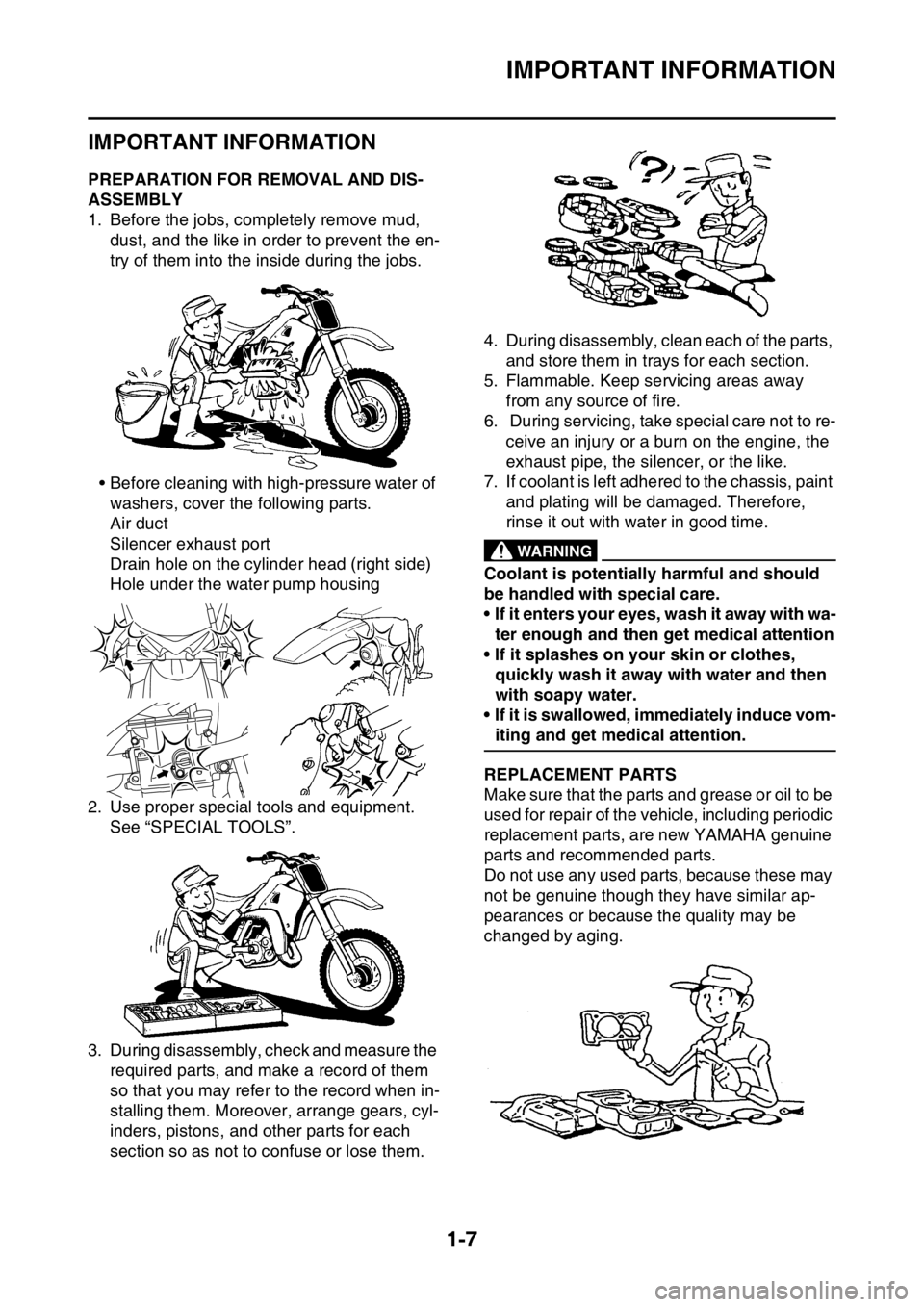
IMPORTANT INFORMATION
1-7
EAS20180
IMPORTANT INFORMATION
EAS2GBB020PREPARATION FOR REMOVAL AND DIS-
ASSEMBLY
1. Before the jobs, completely remove mud,
dust, and the like in order to prevent the en-
try of them into the inside during the jobs.
• Before cleaning with high-pressure water of
washers, cover the following parts.
Air duct
Silencer exhaust port
Drain hole on the cylinder head (right side)
Hole under the water pump housing
2. Use proper special tools and equipment.
See “SPECIAL TOOLS”.
3. During disassembly, check and measure the
required parts, and make a record of them
so that you may refer to the record when in-
stalling them. Moreover, arrange gears, cyl-
inders, pistons, and other parts for each
section so as not to confuse or lose them.4. During disassembly, clean each of the parts,
and store them in trays for each section.
5. Flammable. Keep servicing areas away
from any source of fire.
6. During servicing, take special care not to re-
ceive an injury or a burn on the engine, the
exhaust pipe, the silencer, or the like.
7. If coolant is left adhered to the chassis, paint
and plating will be damaged. Therefore,
rinse it out with water in good time.
EWA
WARNING
Coolant is potentially harmful and should
be handled with special care.
• If it enters your eyes, wash it away with wa-
ter enough and then get medical attention
• If it splashes on your skin or clothes,
quickly wash it away with water and then
with soapy water.
• If it is swallowed, immediately induce vom-
iting and get medical attention.
EAS2GBB021REPLACEMENT PARTS
Make sure that the parts and grease or oil to be
used for repair of the vehicle, including periodic
replacement parts, are new YAMAHA genuine
parts and recommended parts.
Do not use any used parts, because these may
not be genuine though they have similar ap-
pearances or because the quality may be
changed by aging.
Page 33 of 432
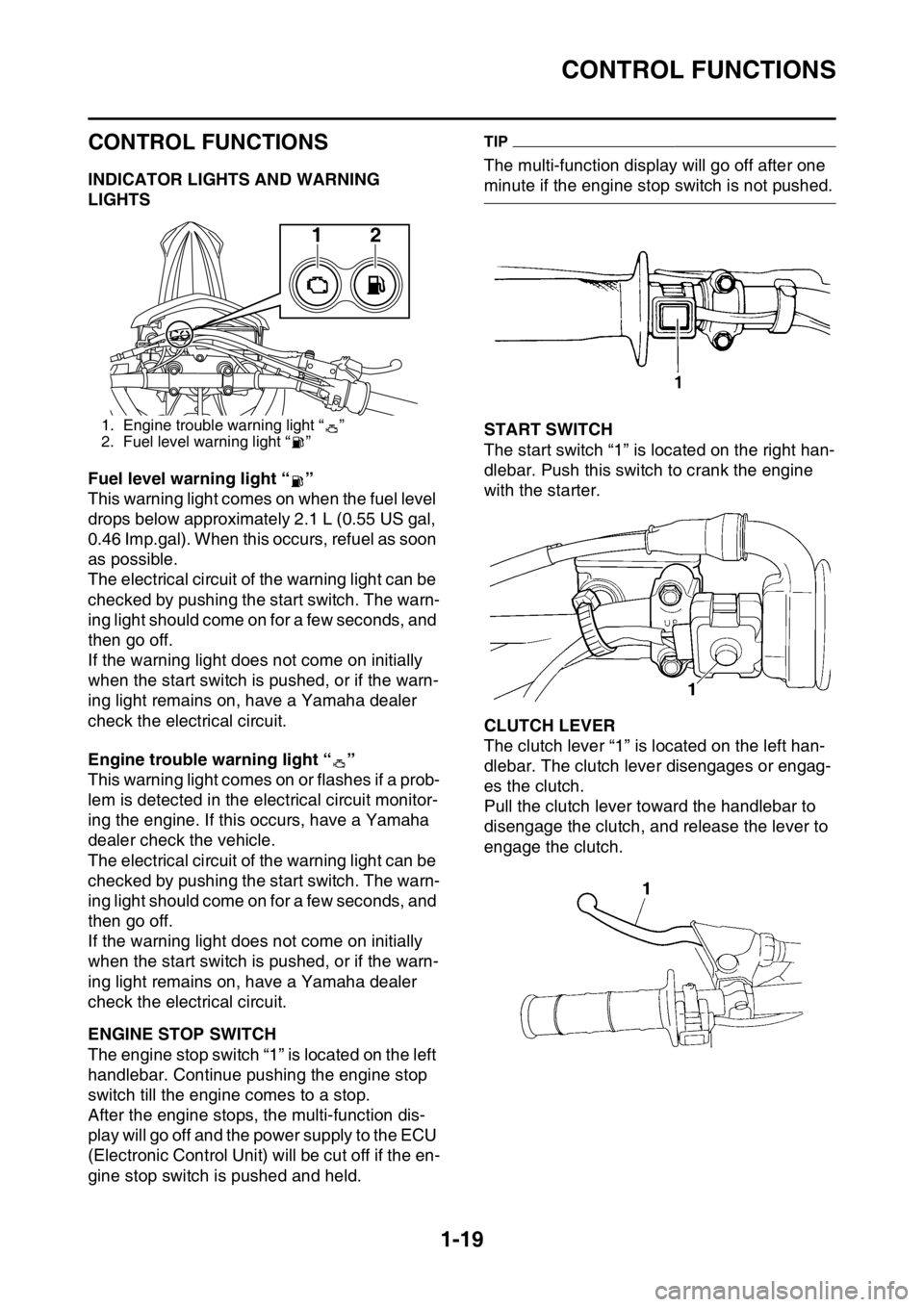
CONTROL FUNCTIONS
1-19
EAS2GBB029
CONTROL FUNCTIONS
EAS2GBB030INDICATOR LIGHTS AND WARNING
LIGHTS
Fuel level warning light “ ”
This warning light comes on when the fuel level
drops below approximately 2.1 L (0.55 US gal,
0.46 Imp.gal). When this occurs, refuel as soon
as possible.
The electrical circuit of the warning light can be
checked by pushing the start switch. The warn-
ing light should come on for a few seconds, and
then go off.
If the warning light does not come on initially
when the start switch is pushed, or if the warn-
ing light remains on, have a Yamaha dealer
check the electrical circuit.
Engine trouble warning light “ ”
This warning light comes on or flashes if a prob-
lem is detected in the electrical circuit monitor-
ing the engine. If this occurs, have a Yamaha
dealer check the vehicle.
The electrical circuit of the warning light can be
checked by pushing the start switch. The warn-
ing light should come on for a few seconds, and
then go off.
If the warning light does not come on initially
when the start switch is pushed, or if the warn-
ing light remains on, have a Yamaha dealer
check the electrical circuit.
EAS2GBB031ENGINE STOP SWITCH
The engine stop switch “1” is located on the left
handlebar. Continue pushing the engine stop
switch till the engine comes to a stop.
After the engine stops, the multi-function dis-
play will go off and the power supply to the ECU
(Electronic Control Unit) will be cut off if the en-
gine stop switch is pushed and held.
TIP
The multi-function display will go off after one
minute if the engine stop switch is not pushed.
EAS2GBB032START SWITCH
The start switch “1” is located on the right han-
dlebar. Push this switch to crank the engine
with the starter.
EAS2GBB033CLUTCH LEVER
The clutch lever “1” is located on the left han-
dlebar. The clutch lever disengages or engag-
es the clutch.
Pull the clutch lever toward the handlebar to
disengage the clutch, and release the lever to
engage the clutch.
EAS2GBB034
1. Engine trouble warning light “ ”
2. Fuel level warning light “ ”
12
Page 35 of 432
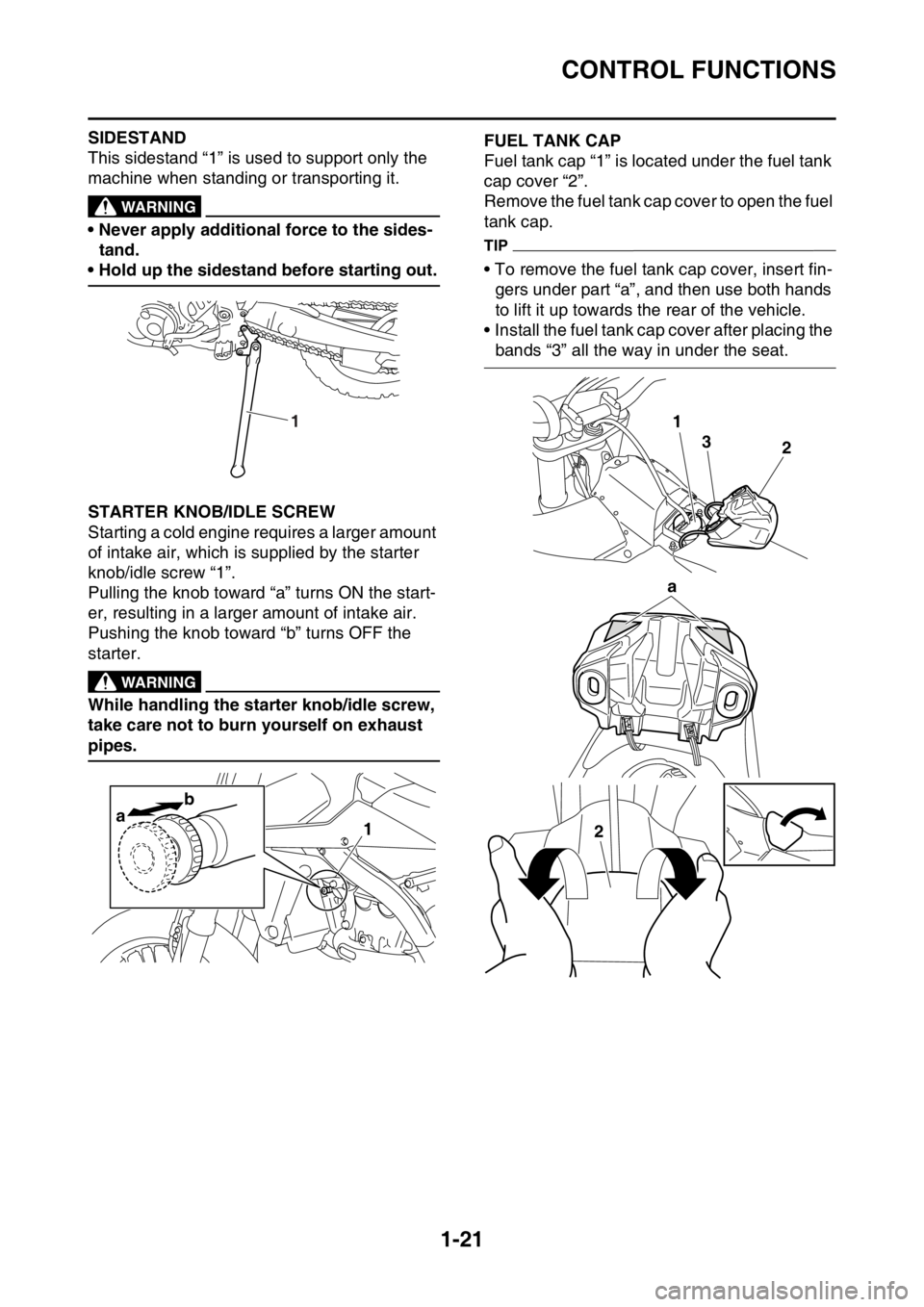
CONTROL FUNCTIONS
1-21
SIDESTAND
This sidestand “1” is used to support only the
machine when standing or transporting it.
EWA
WARNING
• Never apply additional force to the sides-
tand.
• Hold up the sidestand before starting out.
EAS2GBB040STARTER KNOB/IDLE SCREW
Starting a cold engine requires a larger amount
of intake air, which is supplied by the starter
knob/idle screw “1”.
Pulling the knob toward “a” turns ON the start-
er, resulting in a larger amount of intake air.
Pushing the knob toward “b” turns OFF the
starter.
EWA
WARNING
While handling the starter knob/idle screw,
take care not to burn yourself on exhaust
pipes.
EAS2GBB041FUEL TANK CAP
Fuel tank cap “1” is located under the fuel tank
cap cover “2”.
Remove the fuel tank cap cover to open the fuel
tank cap.
TIP
• To remove the fuel tank cap cover, insert fin-
gers under part “a”, and then use both hands
to lift it up towards the rear of the vehicle.
• Install the fuel tank cap cover after placing the
bands “3” all the way in under the seat.
1
ab1
1
23
a
2
Page 36 of 432
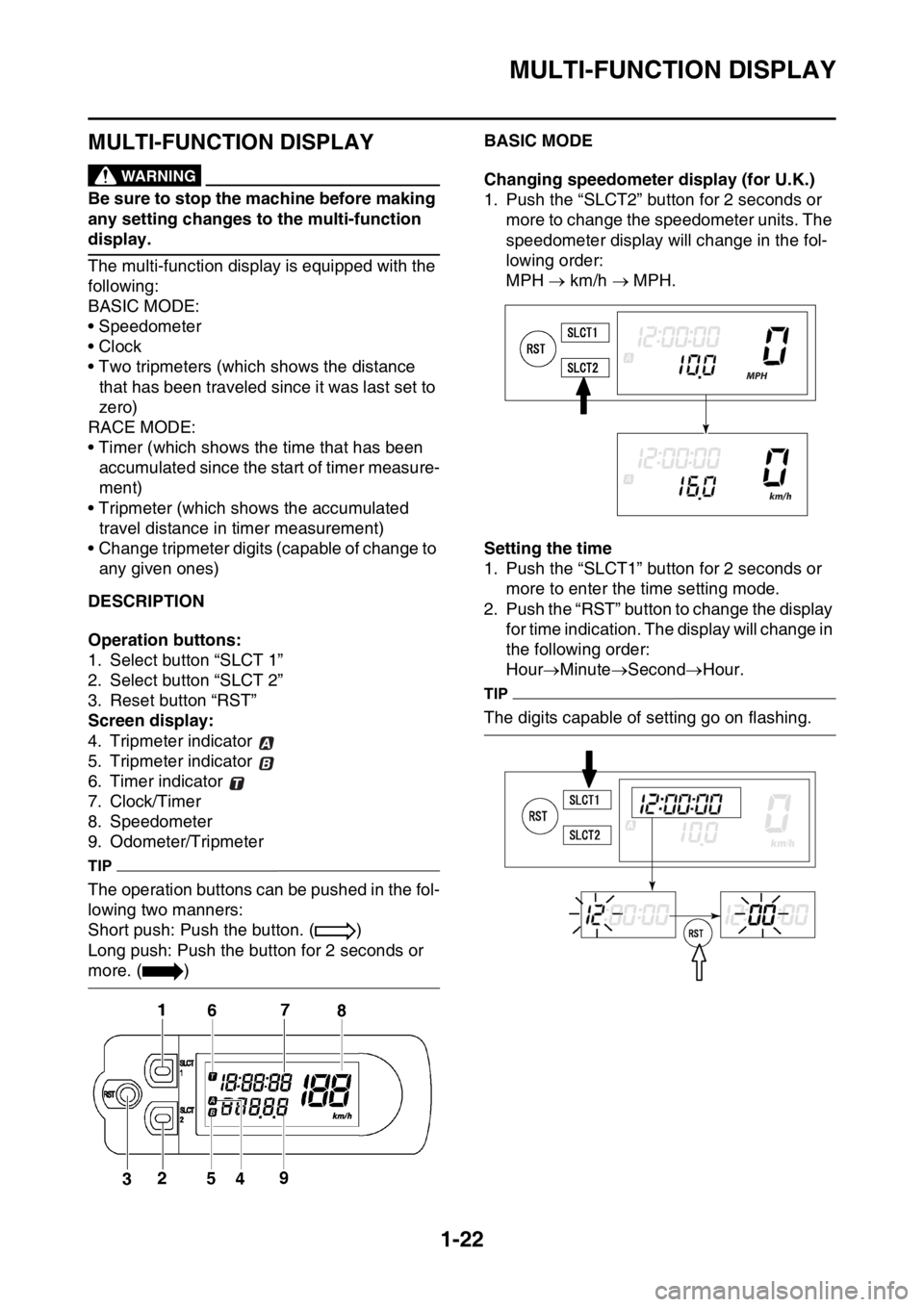
MULTI-FUNCTION DISPLAY
1-22
EAS2GBB042
MULTI-FUNCTION DISPLAYEWA
WARNING
Be sure to stop the machine before making
any setting changes to the multi-function
display.
The multi-function display is equipped with the
following:
BASIC MODE:
• Speedometer
•Clock
• Two tripmeters (which shows the distance
that has been traveled since it was last set to
zero)
RACE MODE:
• Timer (which shows the time that has been
accumulated since the start of timer measure-
ment)
• Tripmeter (which shows the accumulated
travel distance in timer measurement)
• Change tripmeter digits (capable of change to
any given ones)
EAS2GBB043DESCRIPTION
Operation buttons:
1. Select button “SLCT 1”
2. Select button “SLCT 2”
3. Reset button “RST”
Screen display:
4. Tripmeter indicator
5. Tripmeter indicator
6. Timer indicator
7. Clock/Timer
8. Speedometer
9. Odometer/Tripmeter
TIP
The operation buttons can be pushed in the fol-
lowing two manners:
Short push: Push the button. ( )
Long push: Push the button for 2 seconds or
more. ( )
EAS2GBB044BASIC MODE
Changing speedometer display (for U.K.)
1. Push the “SLCT2” button for 2 seconds or
more to change the speedometer units. The
speedometer display will change in the fol-
lowing order:
MPH km/h MPH.
Setting the time
1. Push the “SLCT1” button for 2 seconds or
more to enter the time setting mode.
2. Push the “RST” button to change the display
for time indication. The display will change in
the following order:
HourMinuteSecondHour.
TIP
The digits capable of setting go on flashing.
Page 44 of 432

STARTING AND BREAK-IN
1-30
EAS2GBB048
STARTING AND BREAK-IN
EAS2GBB049FUEL
Always use the recommended fuel as stated
below. Also, be sure to use new gasoline the
day of a race.
ECA
NOTICE
Use only unleaded gasoline. The use of
leaded gasoline will cause severe damage
to the engine internal parts such as valves,
piston rings, and exhaust system, etc.
TIP
Your Yamaha engine has been designed to use
premium unleaded gasoline with a pump oc-
tane number [(R+M)/2] of 91 or higher, or a re-
search octane number of 95 or higher. If
knocking (or pinging) occurs, use a gasoline of
a different brand.
EWA
WARNING
• For refueling, be sure to stop the engine
and use enough care not to spill any fuel.
Also be sure to avoid refueling close to a
fire.
• Refuel after the engine, exhaust pipe, etc.
have cooled off.
Gasohol (For USA and Canada)
There are two types of gasohol: gasohol con-
taining ethanol and that containing methanol.
Gasohol containing ethanol can be used if the
ethanol content does not exceed 10%. Gasohol
containing methanol is not recommended by
Yamaha because it can cause damage to the
fuel system or vehicle performance problems.
EAS2GBB050HANDLING NOTEEWA
WARNING
Never start or run the engine in a closed ar-
ea. The exhaust fumes are poisonous; they
can cause loss of consciousness and death
in a very short time. Always operate the ma-
chine in a well-ventilated area.
ECA
NOTICE
• Unlike a two-stroke engine, this engine
cannot be kick started when the throttle is
open because the kickstarter may kick
back. Also, if the throttle is open the air/
fuel mixture may be too lean for the engine
to start.
• Before starting the machine, perform the
checks in the pre-operation check list.
EAS2GBB051AIR FILTER MAINTENANCE
According to “CLEANING THE AIR FILTER
ELEMENT” section in the CHAPTER 3, apply
the Yamaha foam air filter oil or other quality
foam air filter oil to the element. (Excess oil in
the element may adversely affect engine start-
ing.)
EAS2GBB052STARTING A COLD ENGINEECA
NOTICE
For maximum engine life, never accelerate
hard when the engine is cold!
In order for the ignition circuit cut-off system to
enable starting, one of the following conditions
must be met:
• The transmission is in the neutral position.
• The transmission is in gear with the clutch le-
ver pulled.
1. Pull the starter knob/idle screw “1” to its full
length.
TIP
When the ambient temperature is 15°C (59°F)
or below, use the starter knob/idle screw.
2. Completely close the throttle. Recommended fuel
Premium unleaded gasoline
only
Fuel tank capacity
7.5 L (2.0 US gal, 1.7 lmp.gal)
Fuel reserve amount
2.1 L (0.55 US gal, 0.46 lmp.gal)
1
Page 45 of 432
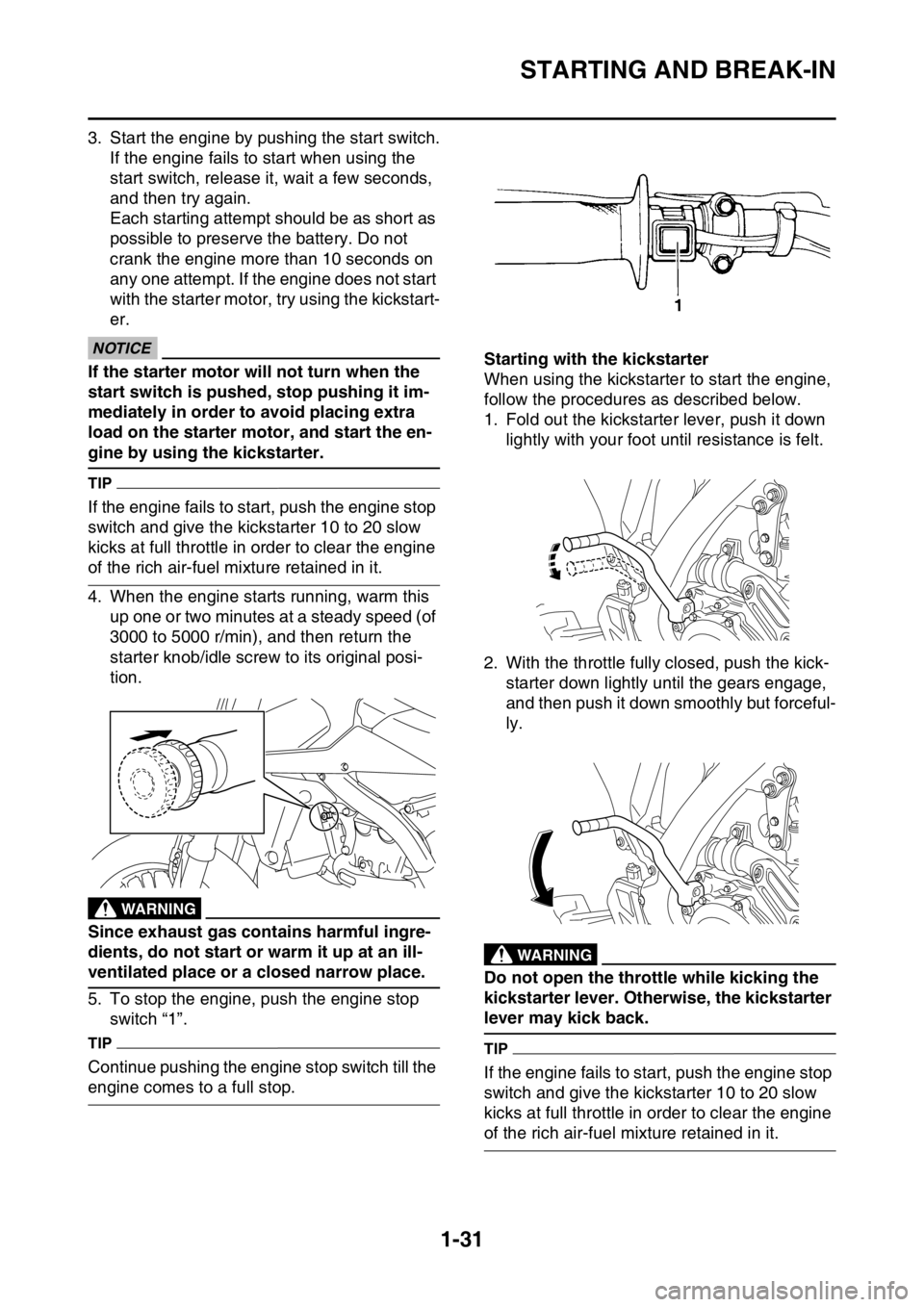
STARTING AND BREAK-IN
1-31
3. Start the engine by pushing the start switch.
If the engine fails to start when using the
start switch, release it, wait a few seconds,
and then try again.
Each starting attempt should be as short as
possible to preserve the battery. Do not
crank the engine more than 10 seconds on
any one attempt. If the engine does not start
with the starter motor, try using the kickstart-
er.
ECA
NOTICE
If the starter motor will not turn when the
start switch is pushed, stop pushing it im-
mediately in order to avoid placing extra
load on the starter motor, and start the en-
gine by using the kickstarter.
TIP
If the engine fails to start, push the engine stop
switch and give the kickstarter 10 to 20 slow
kicks at full throttle in order to clear the engine
of the rich air-fuel mixture retained in it.
4. When the engine starts running, warm this
up one or two minutes at a steady speed (of
3000 to 5000 r/min), and then return the
starter knob/idle screw to its original posi-
tion.
EWA
WARNING
Since exhaust gas contains harmful ingre-
dients, do not start or warm it up at an ill-
ventilated place or a closed narrow place.
5. To stop the engine, push the engine stop
switch “1”.
TIP
Continue pushing the engine stop switch till the
engine comes to a full stop.Starting with the kickstarter
When using the kickstarter to start the engine,
follow the procedures as described below.
1. Fold out the kickstarter lever, push it down
lightly with your foot until resistance is felt.
2. With the throttle fully closed, push the kick-
starter down lightly until the gears engage,
and then push it down smoothly but forceful-
ly.
EWA
WARNING
Do not open the throttle while kicking the
kickstarter lever. Otherwise, the kickstarter
lever may kick back.
TIP
If the engine fails to start, push the engine stop
switch and give the kickstarter 10 to 20 slow
kicks at full throttle in order to clear the engine
of the rich air-fuel mixture retained in it.
Page 51 of 432

MOTORCYCLE CARE AND STORAGE
1-37
2. Apply a corrosion protection spray on all
metal, including chrome- and nickel-plated,
surfaces to prevent corrosion.
After cleaning
1. Dry the motorcycle with a chamois or an ab-
sorbing cloth.
2. Immediately dry the drive chain and lubri-
cate it to prevent it from rusting.
3. Use a chrome polish to shine chrome, alumi-
num and stainless- steel parts, including the
exhaust system. (Even the thermally in-
duced discoloring of stainless- steel exhaust
systems can be removed through polishing.)
4. To prevent corrosion, it is recommended to
apply a corrosion protection spray on all
metal, including chrome- and nickel-plated,
surfaces.
5. Use spray oil as a universal cleaner to re-
move any remaining dirt.
6. Touch up minor paint damage caused by
stones, etc.
7. Wax all painted surfaces.
8. Let the motorcycle dry completely before
storing or covering it.
EWA
WARNING
Contaminants on the brakes or tires can
cause loss of control.
• Make sure that there is no oil or wax on the
brakes or tires.
• If necessary, clean the brake discs and
brake linings with a regular brake disc
cleaner or acetone, and wash the tires with
warm water and a mild detergent. Before
riding at higher speeds, test the motorcy-
cle’s braking performance and cornering
behavior.
ECA
NOTICE
• Apply spray oil and wax sparingly and
make sure to wipe off any excess.
• Never apply oil or wax to any rubber and
plastic parts, but treat them with a suitable
care product.
• Avoid using abrasive polishing com-
pounds as they will wear away the paint.
TIP
• Consult a Yamaha dealer for advice on what
products to use.
• Washing, rainy weather or humid climates
can cause the headlight lens to fog. Turning
the headlight on for a short period of time will
help remove the moisture from the lens.
EAS2GBB060STORAGE
Short-term
Always store your motorcycle in a cool, dry
place and, if necessary, protect it against dust
with a porous cover. Be sure the engine and the
exhaust system are cool before covering the
motorcycle.
ECA
NOTICE
• Storing the motorcycle in a poorly ventilat-
ed room or covering it with a tarp, while it
is still wet, will allow water and humidity to
seep in and cause rust.
• To prevent corrosion, avoid damp cellars,
stables (because of the presence of am-
monia) and areas where strong chemicals
are stored.
Long-term
Before storing your motorcycle for several
months:
1. Follow all the instructions in the “Care” sec-
tion of this chapter.
2. Fill up the fuel tank and add fuel stabilizer (if
available) to prevent the fuel tank from rust-
ing and the fuel from deteriorating.
3. Perform the following steps to protect the
cylinder, piston rings, etc. from corrosion.
▼▼▼▼▼▼▼▼▼▼▼▼▼▼▼▼▼▼▼▼▼▼▼▼▼▼▼▼▼▼▼▼
a. Remove the spark plug cap and spark plug.
b. Pour a teaspoonful of engine oil into the
spark plug bore.
c. Install the spark plug cap onto the spark
plug, and then place the spark plug on the
cylinder head so that the electrodes are
grounded. (This will limit sparking during the
next step.)
d. Turn the engine over several times with the
starter. (This will coat the cylinder wall with
oil.)
Page 52 of 432

MOTORCYCLE CARE AND STORAGE
1-38
e. Remove the spark plug cap from the spark
plug, and then install the spark plug and the
spark plug cap. WARNING! To prevent
damage or injury from sparking, make
sure to ground the spark plug electrodes
while turning the engine over.
▲▲▲▲▲▲▲▲▲▲▲▲▲▲▲▲▲▲▲▲▲▲▲▲▲▲▲▲▲▲▲▲
4. Lubricate all control cables and the pivoting
points of all levers and pedals as well as of
the sidestand/ centerstand.
5. Check and, if necessary, correct the tire air
pressure, and then lift the motorcycle so that
both of its wheels are off the ground. Alter-
natively, turn the wheels a little every month
in order to prevent the tires from becoming
degraded in one spot.
6. Cover the muffler outlet with a plastic bag to
prevent moisture from entering it.
7. Remove the battery and fully charge it. Store
it in a cool, dry place and charge it once a
month. Do not store the battery in an exces-
sively cold or warm place [less than 0 °C (30
°F) or more than 30 °C (90 °F)]. For more in-
formation on storing the battery, See page
9-69.
TIP
Make any necessary repairs before storing the
motorcycle.